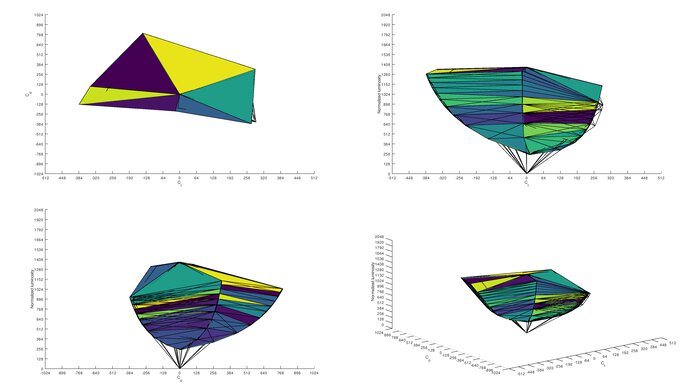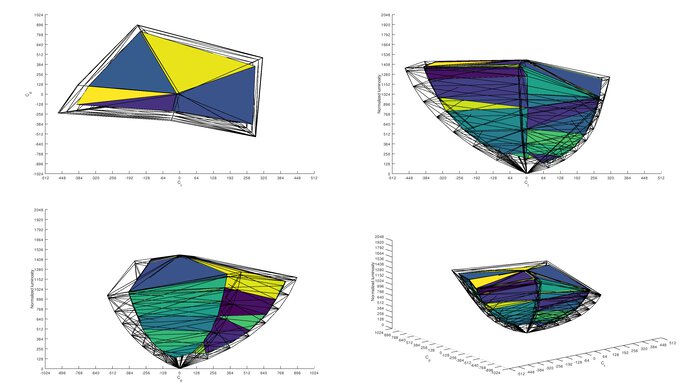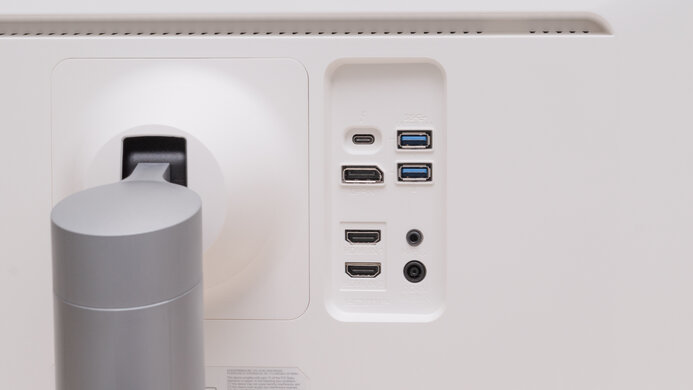The LG 38WN95C-W is a great ultrawide, curved screen monitor with an IPS panel. It has a ton of features aimed at improving your workflow at the office. It has a Picture-by-Picture mode, allowing you to display images from two input sources at once. Its Thunderbolt 3 support lets you display an image from a compatible device and charge it at the same time, and provides higher bandwidth and power delivery compared to a DisplayPort Alt Mode connection. Its uncommon 3840x1600 packs in more vertical pixels, allowing you to see crisp, detailed images. Despite being mainly designed for the office, it's packed with gaming perks, such as FreeSync variable refresh rate (VRR) support, G-SYNC compatibility, a remarkable response time, and low input lag. It gets very bright and makes highlights pop in HDR, but doesn't perform very well in a dark room. Its low contrast ratio means blacks appear closer to gray, and it has a terrible local dimming feature.
Our Verdict
The LG 38WN95C-W is a great overall monitor. It's very good for office use or watching content, because it gets bright enough to combat glare, has wide viewing angles, and displays a wide color gamut. It's impressive for gaming due to its extremely quick response time, incredibly low input lag, and FreeSync support. HDR content looks good as it gets bright enough to bring out highlights, but it has a low contrast ratio and the local dimming feature is terrible.
- Wide viewing angles.
- Gets very bright.
- Remarkable response time.
- High resolution.
- Low contrast ratio.
- Terrible local dimming feature.
The LG 38WN95C-W is very good for office use. The 38 inch, 3840x1600 screen provides enough space for you to open multiple windows at once. It gets bright enough to combat glare, but the reflections may be too distracting if it's placed opposite a window. Even though the stand doesn't offer much in terms of ergonomics, it has wide viewing angles, making it easier to share your screen with others.
- Wide viewing angles.
- Gets very bright.
- Thunderbolt 3 support.
- Disappointing ergonomics.
- Struggles with direct sunlight.
The LG 38WN95C-W is impressive for gaming. It's packed with gaming features such as FreeSync support, G-SYNC compatibility, low input lag, and a remarkable response time. Unfortunately, it doesn't have a Black Frame Insertion feature to improve the appearance of motion. The low contrast ratio means it's not ideal for dark-room gaming. However, it has wide viewing angles, great for co-op gaming.
- VRR support.
- Remarkable response time.
- Incredibly low input lag.
- Low contrast ratio.
The LG 38WN95C-W is very good for multimedia use. Its 3840x1600 resolution allows you to watch high-resolution videos online, and the wide viewing angles means you can easily watch content with friends. Unfortunately, it has a low contrast ratio, so blacks appear closer to gray when viewed in the dark. Fortunately, it performs well in bright environments because it gets bright enough to combat glare.
- Wide viewing angles.
- Gets very bright.
- High resolution.
- Disappointing ergonomics.
- Low contrast ratio.
Great for media creation. The LG 38WN95C-W's high resolution allows you to see images in fine detail. It has excellent coverage of the Adobe RGB color space used in photo editing, and it displays a wide color gamut for HDR content. It has limited ergonomics, so it may be difficult to place in an ideal position, but it has wide viewing angles if you need to share your screen with others.
- Wide viewing angles.
- Gets very bright.
- Thunderbolt 3 support.
- Exceptional gradient handling.
- Disappointing ergonomics.
- Low contrast ratio.
The LG 38WN95C-W is decent for HDR. It displays a wide range of colors in HDR for a life-like image and gets bright enough to make highlights stand out thanks to its great peak brightness. However, it struggles in dark rooms because of its low native contrast ratio, and while it has a local dimming feature, it performs terribly.
- Gets very bright.
- Exceptional gradient handling.
- High resolution.
- Low contrast ratio.
- Terrible local dimming feature.
Changelog
- Updated May 03, 2024: Added that the Dell U4025QW has better Contrast.
- Updated Feb 01, 2023: Added text in the macOS Compatibility and Console Compatibility boxes and clarified text throughout as part of Test Bench 1.2.
- Updated Feb 01, 2023: Updated to Test Bench 1.2, resulting in changes to the results and scores with the Response Time and Input Lag. Added tests for Console Compatibility and macOS compatibility and made minor changes to other tests, which you can see in our Changelog.
- Updated Sep 21, 2020: Review published.
Check Price
Differences Between Sizes And Variants
We tested the LG 38WN95C-W, which is the only size available for this monitor. If you have this monitor and it's different from ours, let us know and we'll update the review.
Note that some tests, such as gray uniformity, may vary between units. Our unit was manufactured in May 2020, and you can see the label here.
Popular Monitor Comparisons
The LG 38WN95C-W is a great ultrawide monitor that's very versatile. It's great for office use, and if you want to game with it after work, it provides all of the gaming features you need. It's also one of the brightest we've seen in HDR, which is a nice touch. However, it's the same price as some larger TVs, and if you don't need all of its extra features, there are cheaper ultrawide options out there, like the Dell U3818DW. Also see our recommendations for the best ultrawide monitors, the best 34-49 inch monitors, and the best office monitors.
The LG 38WN95C-W and the Dell AW3821DW are each very good overall monitors. They're both 38 inch models with a 3840x1600 resolution and a 144Hz refresh rate. The LG is mainly designed for office use, but it's slightly better than the Dell for gaming because it has a quicker response time, resulting in clearer motion. It's also slightly better for HDR gaming because it gets much brighter in HDR. However, if you have an NVIDIA graphics card, the Dell may be a better choice for you because it has native G-SYNC support.
The LG 38WN95C-W and the Dell U4025QW are both large, ultrawide productivity and editing monitors. The Dell is the better choice if you're looking for better image quality and more productivity features. The Dell displays deeper blacks that appear less gray in a dark room than on the LG. Additionally, the Dell has productivity-enhancing features such as a KVM switch and the ability to subdivide the screen into multiple smaller virtual monitors for easier window management. However, the LG is a better choice for brighter environments, as it gets far brighter in both SDR and HDR.
The LG 38WN95C-W is much better than the Dell U3818DW. The LG gets much brighter, supports HDR, displays a wider color gamut, and it has more gaming features like VRR support and a 144Hz refresh rate. However, the Dell has better ergonomics, has better color accuracy, and there two more USB ports.
Although the LG 38GN950-B and the LG 38WN95C-W are very different in their outer design, they're actually quite similar. The main difference is that the 38GN950-B's 144Hz refresh rate can be overclocked up to 160Hz. The 38GN950-B has a better HDR color gamut and volume, and it gets a bit brighter overall. The 38WN95C-W has a few more features, like a USB-C port with Thunderbolt 3 support and built-in speakers.

We buy and test more than 30 monitors each year, with units that we buy completely on our own, without any cherry-picked units or samples. We put a lot into each unbiased, straight-to-the-point review, and there's a whole process from purchasing to publishing, involving multiple teams and people. We do more than just use the monitor for a week; we use specialized and custom tools to measure various aspects with objective data-based results. We also consider multiple factors before making any recommendations, including the monitor's cost, its performance against the competition, and whether or not it's easy to find.
Test Results

The LG 38WN95C-W is a curved screen, ultrawide monitor that looks a lot like the LG 49WL95C-W. It has a gray arc-shaped stand that's very wide, but you can still place stuff in front of it. The back of the monitor is white, while the bezels in front are black, and it should look good in any office environment. It feels well-built, but the monitor does wobble quite easily.
Good build quality. The LG 38WN95C-W is made of good-quality plastic that feels solid, and the stand holds it well. The screen wobbles quite easily, and it even tilts a bit to the left and right. We don't know if this is an issue with our unit or a common problem. If you have this monitor, let us know in the discussions.
It has mediocre ergonomics, which is typical of LG's office monitors. It has a fairly narrow tilt and swivel range, and as expected from an ultrawide, you can't rotate it into portrait mode.
It has a plain, white back panel. There's a quick-release button if you need to remove the stand to VESA-mount it. Also, there's a hook on the stand for cable management.
The LG 38WN95C-W has a disappointing contrast ratio, which is expected from an IPS panel. Blacks appear closer to gray when viewed in the dark, and the local dimming feature doesn't improve it very much. If you're looking for a monitor with better contrast, check out the Dell U4025QW.
Like most monitors, the LG 38WN95C-W has a terrible edge-lit local dimming feature. The lighting zones are very large, so zone transitions are easy to see. If there's a bright object on the screen in real content, most of the zones light up, and it doesn't look good. If a single zone lights up in a completely dark scene, it causes a distracting flicker.
The LG 38WN95C-W has impressive brightness in SDR, and it's a lot brighter than the LG 40WP95C-W. It easily gets bright enough to combat glare, and its brightness remains very consistent with different content, which is great.
We measured peak brightness after calibration with Local Dimming on.
The LG 38WN95C-W has great peak brightness in HDR. It gets bright enough to truly bring out highlights in HDR. Its EOTF also follows the target PQ curve very well until there's a slow roll-off at the peak brightness, meaning it preserves bright details well.
We measured HDR brightness in the 'Custom' Picture Mode with Local Dimming on.
Good horizontal viewing angle, which is expected from an IPS panel. The image remains accurate when viewing from the sides, which is ideal if you need to share your screen with others.
Decent vertical viewing angle. The image remains fairly accurate if you mount it above eye-level.
This monitor has mediocre black uniformity. There's clouding throughout the entire screen and some backlight bleed along the top and bottom edges, especially near the bottom-right corner. The local dimming feature doesn't really improve the uniformity.
The LG 38WN95C-W has impressive accuracy before calibration. It has a dedicated sRGB mode that locks the colors to the sRGB color space so that they aren't oversaturated. The white balance is good, and the color temperature is very close to the 6500K target. Gamma is also good, but it's too dark for dark scenes and too bright in bright scenes.
Unfortunately, the sRGB mode locks many settings, including the Response Time and Color Adjust settings. If you want to keep those enabled, you need to use another picture mode that has oversaturated colors.
After calibration, it has remarkable color accuracy. Any remaining color and white balance inaccuracies aren't visible to the naked eye. Gamma is slightly below the target of 2.2, so some scenes are still brighter than expected.
Good text clarity. It can be improved by enabling ClearType (top photo). This helps the appearance of the diagonal and curved lines as seen on the letters R, N, G, and S. For a monitor with exceptional text clarity, see the Dell UltraSharp U4021QW.
You can only reach this monitor's max refresh rate with a DisplayPort connection due to bandwidth limitations over HDMI.
The LG 38WN95C-W has native FreeSync support, and it's certified by NVIDIA to be G-SYNC compatible with a DisplayPort connection. Over HDMI the minimum refresh rate is 48Hz and only FreeSync works.
| Overdrive Setting | Response Time Chart | Response Time Tables | Motion Blur Photo |
| Off | Chart | Table | Photo |
| Normal | Chart | Table | Photo |
| Fast | Chart | Table | Photo |
| Faster | Chart | Table | Photo |
This monitor has a remarkable response time at its max refresh rate of 144Hz. Motion looks very smooth and there's hardly any motion blur. The recommended overdrive setting is 'Normal' because it has a faster total response time and less overshoot than 'Fast'.
| Overdrive Setting | Response Time Chart | Response Time Tables | Motion Blur Photo |
| Off | Chart | Table | Photo |
| Normal | Chart | Table | Photo |
| Fast | Chart | Table | Photo |
| Faster | Chart | Table | Photo |
The response time at 120Hz remains extremely quick. Once again the recommended overdrive setting is 'Normal' as 'Fast' has more overshoot.
| Overdrive Setting | Response Time Chart | Response Time Tables | Motion Blur Photo |
| Off | Chart | Table | Photo |
| Normal | Chart | Table | Photo |
| Fast | Chart | Table | Photo |
| Faster | Chart | Table | Photo |
The LG 38WN95C-W has a great response time at 60Hz. The 'Normal' overdrive setting remains the recommended one because 'Fast' has a lot more overshoot at 60Hz. This means you can use 'Normal' as a set-and-forget mode if the frame rate of your game drops.
The LG 38WN95C-W doesn't have a backlight strobing feature, even though LG advertises that it has Motion Blur Reduction.
The LG 38WN95C-W has amazing low input lag for a responsive feel while gaming.
The LG 38WN95C-W has an excellent and uncommon 3840x1600 resolution. It has about the same pixel density as a 34-inch 1440p monitor with a 21:9 aspect ratio, such as the LG 34GN850-B. This screen provides you enough space to open multiple windows at once, and it delivers crisp images.
The LG 38WN95C-W doesn't support all common resolutions from the PS5. Only 1440p works with 120Hz signals, even if you set your resolution to 4k, and 4k @ 120Hz doesn't work due to bandwidth limitations. If you want to play 4k @ 60Hz games, you have to disable 120Hz first. Because the PS5 doesn't support ultrawide gaming, you'll see black bars on the sides.
Unlike with the PS5, this monitor doesn't have many issues with the Xbox Series X. 1440p @ 120Hz and 1080p @ 60Hz only work with the manual HDMI Override, which also displays VRR. However, VRR and HDR work without issue with 4k @ 60Hz. Because the Xbox doesn't support ultrawide gaming, you'll see black bars on the sides.
The LG 38WN95C-W has a USB-C input that supports Thunderbolt 3, allowing you display an image from a compatible device and charge it at the same time. Thunderbolt 3 has a higher power delivery and bandwidth than a DisplayPort Alt Mode connection. If you need higher bandwidth or support for daisy chaining, check out the LG 40WP95C-W instead.
The LG 38WN95C-W works well with recent M1 MacBooks over its USB-C connection. You can close the lid of the laptop and continue working on the monitor, and there aren't any issues when opening the lid again. HDR looks okay, but it doesn't get very bright. Unfortunately, VRR doesn't work with the USB-C connection, so you need to connect to it via DisplayPort for VRR to work. However, using that connection also causes stutter with low-frame-rate signals.
This monitor has built-in speakers and supports Picture-by-Picture mode, allowing to display images from two input sources at once. It also includes the following features:
- Super Resolution Plus: Upscales lower-resolution content.
- Auto Brightness: Automatically adjusts the brightness of the screen based on the brightness of the room.
- Low Blue Light: Removes blue light to help reduce eye strain.




















































